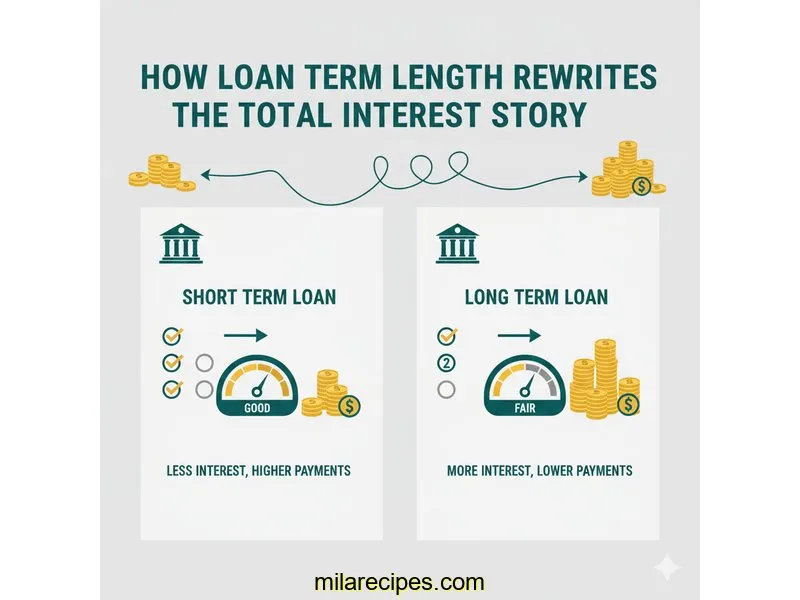
Auto Loan Calculator
Calculate payments over the life of your Loan
Home Blog Privacy Terms About Contact
Calculate payments over the life of your Loan
Home Blog Privacy Terms About ContactPublished on October 26, 2025

My journey into understanding loan math started with a simple conversation. A colleague was excited about a recent personal loan they secured for a home project. They mentioned their monthly payment was surprisingly low, which sounded great. But then they mentioned the loan would take six years to pay off. That juxtaposition stuck with me. How could a payment feel so manageable, yet the timeline feel so long?
It wasn't about judging their choice; it was about the mechanics. My brain started turning over the numbers. Did the lower payment come with a hidden trade-off? Was there a piece of the calculation I was missing that explained this relationship? I realized that while I understood the concept of a loan, I didn't truly grasp the arithmetic that connected the principal, the interest rate, the term, and the monthly payment into one cohesive story.
So, I set a personal goal: to understand not just what the monthly payment was, but why it was what it was. I wanted to see the full narrative that the numbers were telling. This exploration is purely about my process of learning how these calculations work and how online tools can illuminate the process. It's about building financial literacy, not providing financial advice.
I started where most of us do: with an online loan calculator. I plugged in some hypothetical numbers and immediately focused on the one big, bold result—the monthly payment. My initial thought was simple: lower is better. But that simple thought was about to get a lot more complicated, and my initial understanding was about to be completely reshaped.
My first experiments were straightforward. I imagined a hypothetical need for a loan of $18,450. I found a calculator, entered the amount, and put in an interest rate of 7.2%. Then came the crucial field: the loan term. I started with 48 months (four years). The calculator spit out a monthly payment of about $443.49.
"Okay," I thought to myself. "That's a number." But then, remembering my colleague's six-year term, I changed the input from 48 months to 72 months. The page refreshed, and the new monthly payment was $314.93. The difference was huge—nearly $130 less each month. My immediate, gut reaction was that the second option was vastly superior. Who wouldn't want to pay less every month?
This became my point of fixation. For a while, I played with the numbers, but my eyes were always drawn to that single "Monthly Payment" box. I saw it as the primary indicator of affordability. My mistake was in treating it as the *only* indicator of the loan's character. I was so focused on the short-term cash flow that I completely ignored the other data points the calculator was presenting.
The confusion peaked when I noticed other fields, like "Total Principal Paid," "Total Interest Paid," and "Total of All Payments." I glanced at them but didn't truly process their significance. I thought, "The total interest is just some background detail." I couldn't understand why someone would willingly choose a $443 payment when a $314 option was available for the exact same loan amount and interest rate. It felt illogical, and that frustration signaled a major gap in my understanding. I knew I was missing the real story.
The turning point came when I stopped just plugging in numbers and decided to document the results. Instead of letting the calculator's answers disappear with each new query, I opened a simple text document and wrote down the full output for both scenarios—the 48-month term and the 72-month term. Laying them out side-by-side was the key.
Suddenly, it wasn't about one number being "lower" than another. It was about seeing two completely different stories that started from the same place. The monthly payment was just the first sentence of a much longer chapter. The real narrative was in the total interest and the total cost over time. The "aha moment" wasn't a complex mathematical revelation; it was simply the act of comparing the complete set of results.
Seeing the data in this table format made everything click. The lower monthly payment of the 72-month loan wasn't magic; it was simply the result of stretching the same debt over more time. And because the balance remained higher for longer, interest had more time to accumulate. The cost for that lower monthly payment was an extra $1,387.44 in pure interest.
I realized the calculator wasn't just giving me an answer; it was showing me a mathematical relationship. Each monthly payment is composed of two parts: principal (the money that pays down your original loan) and interest (the fee you pay for borrowing). In the early stages of a loan, a larger portion of your payment goes toward interest. With a longer term, you spend many more months in this interest-heavy phase, which is why the total interest grows so dramatically.
To be sure this wasn't a fluke, I ran more numbers. I tried a $12,000 loan at 6.5% interest. Over 36 months, the total interest was about $1,254. When I stretched it to 60 months, the monthly payment dropped, but the total interest climbed to over $2,086. The pattern was consistent. The loan term was a powerful lever that directly impacted the total amount of interest paid. My focus had officially shifted from just the monthly payment to the entire financial picture.

My weekend of playing with numbers and comparing results taught me some fundamental lessons about how loan calculations actually work. It wasn't about finding a "better" loan but about understanding the mechanics behind the numbers presented to me. This knowledge is empowering because it moves the focus from a single data point to the entire system.
It's because interest is calculated on the remaining loan balance. With a longer term, your monthly payments are smaller, which means the loan balance decreases more slowly. Because the balance stays higher for a longer period, you end up paying interest on that larger amount for more months, causing the total interest to accumulate.
While every field is important, I've learned that looking at three numbers together provides the clearest picture: the monthly payment (for cash flow), the loan term (the timeline), and the total interest paid (the true cost of borrowing). Seeing these three in relation to each other tells a comprehensive story.
The key is to change only one variable at a time. To understand the effect of the term, keep the loan amount and interest rate the same and only adjust the term length. To see the effect of the interest rate, keep the loan amount and term the same. This isolates the impact of each component.
It's not inherently misleading, but it can be if it's the only number you focus on. It accurately reflects what you'll owe each month. However, it can conceal the long-term cost in terms of total interest. It's one part of a larger equation, not the final answer itself.
This whole experience was incredibly eye-opening. What started as simple curiosity about a colleague's loan turned into a deep dive into the mechanics of borrowing. My biggest takeaway is that the full story of a loan is never told by a single number. The monthly payment, the term, and the total interest are all interconnected parts of a single mathematical narrative.
Understanding how they influence each other has given me a new sense of clarity. It’s not about fear or avoidance of debt, but about respecting the math behind it. Learning to use a calculator not just for an answer, but as a tool for exploration, was the real prize. It's a skill that helps demystify the numbers and builds a solid foundation for financial understanding.
This article is about understanding calculations and using tools. For financial decisions, always consult a qualified financial professional. My journey was about education, and I hope sharing it helps someone else feel more confident in their own quest for numerical literacy.
Disclaimer: This article documents my personal journey learning about loan calculations and how to use financial calculators. This is educational content about understanding math and using tools—not financial advice. Actual loan terms, rates, and costs vary based on individual circumstances, creditworthiness, and lender policies. Calculator results are estimates for educational purposes. Always verify calculations with your lender and consult a qualified financial advisor before making any financial decisions.